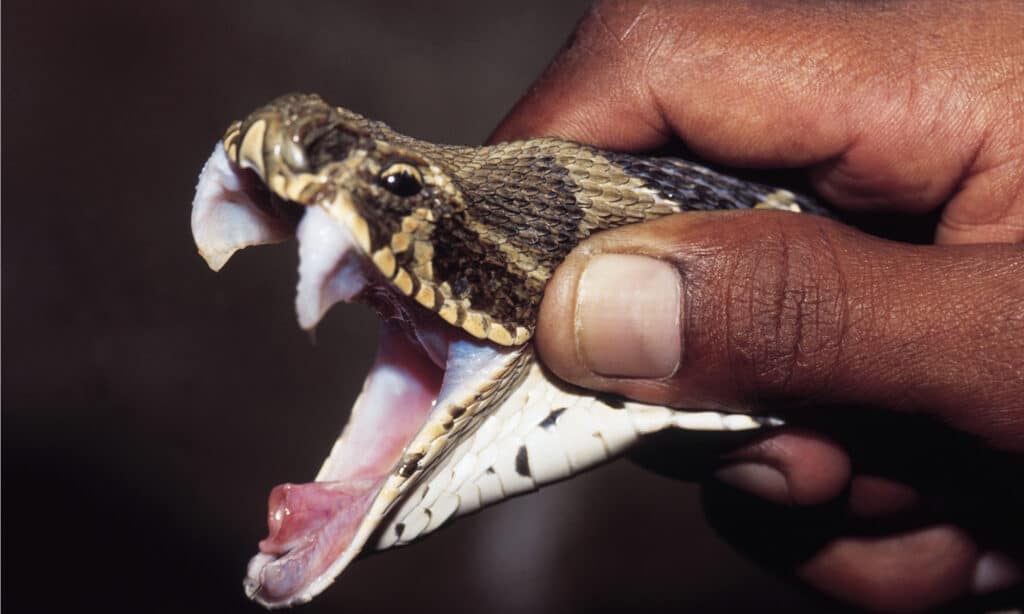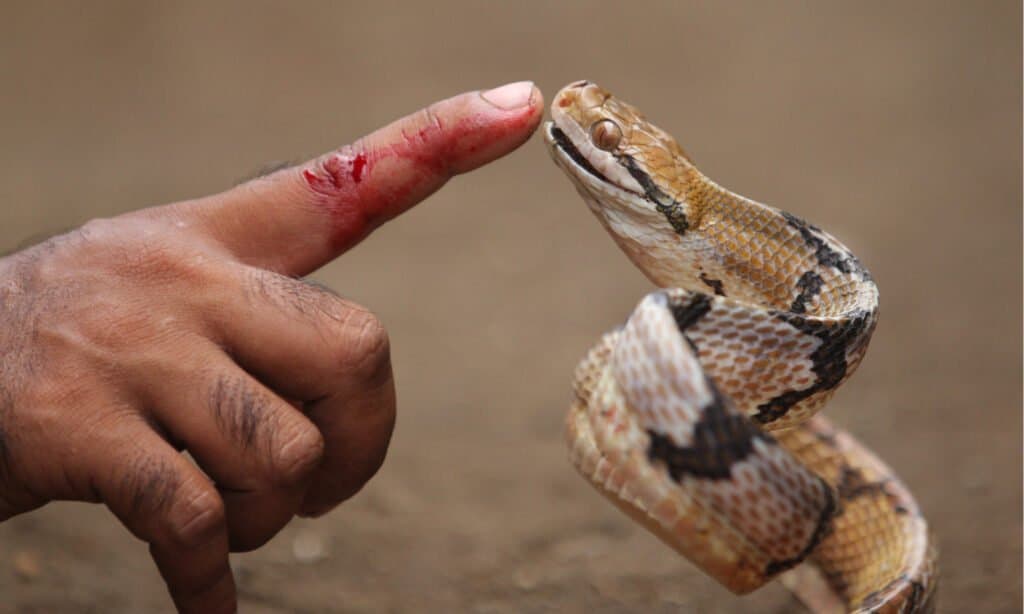If you haven’t heard about how potent the Russell’s viper bite is, now is the time to learn more. This snake is considered one of the top four most dangerous snakes in all of India, but what makes it so dangerous, and what properties in its venom makes it particularly lethal?
In this article, we will take a look at all of the components of a Russell’s viper bite, including how dangerous this snake is when interacting with human beings. We will also address the attack style of this particular snake as well as what to do if you happen to be bitten by one of them. It’s more likely than you think! Let’s get started now.
Why is the Russell’s Viper Bite So Powerful?

The average Russell’s viper bites with as little as 20 mg of venom per bite, or as much as 275 mg per bite.
©jaroslava V/Shutterstock.com
One of the reasons why a bite from the Russell’s viper is so powerful is because of the large amount of venom that it is capable of injecting. Just put things in perspective, the average human being dies after only 40 mg of venom. The Russell’s viper average bite has nearly 300 mg of venom per bite, which means that it is particularly potent.
At the very least, you will know when you are bitten by a Russell’s viper given how painful the bite is. Swelling and bruising at the site of the bite is extremely common for all Russell’s viper victims, and this pain has reportedly continued for as long as 4 weeks after the bite has occurred. Additionally, many fatal symptoms take time to occur in the body, such as blood clotting and kidney failure.
How Much Venom Does a Russell’s Viper Bite Have?
The average Russell’s viper bites with as little as 20 mg of venom per bite, or as much as 275 mg per bite. However, most adult snakes of this type bite with an average of 100 mg, which is more than enough to kill a few people. Juvenile snakes do not utilize as much venom, but it seems pretty obvious how capable the Russell’s viper is of killing 22 humans using a single bite!
To put it into perspective, the average king cobra bites with as much as 1000 mg of venom, a huge increase from the amount of venom found in a Russell’s viper bite. However, the Russell’s viper is more dangerous and responsible for more fatalities overall compared to the king cobra.
Do Russell’s Vipers Bite Repeatedly?

When threatened, the Russell’s viper curls into a variety of shapes, and also lifts the first portion of its body up off the ground.
©RealityImages/Shutterstock.com
One of the things that the Russell’s viper is particularly known for is its aggression. While it is unclear whether or not the Russell’s viper bites repeatedly, it is likely that this is the case. Another interesting fact about the snake is that it has been observed striking humans quickly, as well as biting and hanging on to its victim.
What Animals Do Russell’s Vipers Hunt?
The Russell’s viper is a primarily nocturnal snake, though it will hunt during the daytime once the weather cools. It enjoys a variety of prey, including:
- Rodents
- Scorpions
- Lizards
- Land crabs
- Other reptiles
Juvenile Russell’s vipers have been observed in cannibalistic behavior with other young snakes. An interesting thing to note about Russell’s vipers is that they do not appear to have viper pits, though it seems as if they hunt using infrared technology similar to many other vipers. However, it is still unclear, and there is much more to study when it comes to this aggressive and dangerous snake.
How Do Russell’s Vipers Interact with Humans?

The Russell’s viper is an incredibly strong and powerful snake, capable of jumping far enough to lift its entire body off the ground should it feel threatened enough.
©Mufti Adi Utomo/Shutterstock.com
As we’ve already mentioned, the Russell’s viper is a particularly aggressive breed of snake. However, like all snakes, it does prefer to be left alone and unprovoked. This viper does strike with less warning than many other snakes, though there are some signs to pay attention to should you happen upon a Russell’s viper in the wild.
When threatened, the Russell’s viper curls into a variety of shapes, and also lifts the first portion of its body up off the ground. This is widely considered to be the first and only warning you will receive before the snake leaps into the air to bite you. The Russell’s viper is an incredibly strong and powerful snake, capable of jumping far enough to lift its entire body off the ground should it feel threatened enough.
How Do You Treat a Russell’s Viper Snake Bite?
Just like any other snake bite, it is detrimental to seek out medical care if you happen to be bitten by a Russell’s viper. These snakes are commonly found in populated areas, though they are not as common as other snakes in India such as the cobra. However, they have their fair amount of run-ins with humans, and the Russell’s viper is one of the main culprits of the majority of snake bites in India.
One of the most unfortunate things to note about the victims of Russell’s viper snake bites is that they often suffer from a variety of organ damage and damage to the pituitary gland, long after the snake bite has healed. Many studies suggest that the venom qualities of the Russell’s viper venom is particularly potent, and many victims perish long after the bite has been treated, or deal with unfortunate side effects for the rest of their lives.
As with any snake, the Russell’s viper deserves our respect and caution. There is so much about snakes that we still do not understand, or fully know how to treat. If you happen upon a Russell’s viper in the wild, be careful and cautious, and treat it with utmost care!
The photo featured at the top of this post is © jaroslava V/Shutterstock.com
Discover the "Monster" Snake 5X Bigger than an Anaconda
Every day A-Z Animals sends out some of the most incredible facts in the world from our free newsletter. Want to discover the 10 most beautiful snakes in the world, a "snake island" where you're never more than 3 feet from danger, or a "monster" snake 5X larger than an anaconda? Then sign up right now and you'll start receiving our daily newsletter absolutely free.
Thank you for reading! Have some feedback for us? Contact the AZ Animals editorial team.







